Material Production by Amazon River Communities and its Implications
By José Bittencourt da SILVA, Cledinei Oliveira da SILVA, Márcio Fernando Duarte PINHEIRO, Raimundo Nonato Leite de OLIVEIRA, Roberta da Trindade
There is no human existence without the guarantee of the reproduction of its conditions of material production. These must be guaranteed at the same time as the production process takes place. ‘As Marx said, even a child knows that if a social formation does not reproduce the conditions of production at the same time that it produces, it will not be able to survive a year…’ (ALTHUSSER, 1983, p. 9). The objective of this text is to describe, analytically, the way a riverside community, close to the city of Belém (Brazil), produces and, at the same time, reproduces the conditions of production of its material life.
In this context, the following activities/processes were observed: the food derived from cassava (flour, tucupi, tapioca, croeira and others), backyards with their fruit trees (papayas, cupuaçuzeiros, mango trees and others), small animals (ducks, chickens and pigs), aromatic, medicinal and seasoning herbs (mulberry catinga, lemongrass, capim santo etc.), the planting of priprióca (cyperus articulatus) and pataqueira (schizolobium parahyba) for the sale and production of perfumes by the company, Natura S. A, and tourism based on the potential of the area and the local cuisine.
Materials and method
This text is the result of an exploratory field activity carried out with postgraduate students.1 The investigation aimed at collecting empirical information regarding the community way of life of the riverside inhabitants of the Boa Vista do Acará community, located near the urban centre of Belém, the capital city of the State of Pará in Brazil. How do local families produce their own existence, at the same time that they reproduce the conditions of that production to continue producing and existing in the community, is the question addressed in the study.
The survey was carried out collectively by means of on-site observations, open interviews and photographic records. In this paper, the anthropological approach proposed by Roberto Cardoso de Oliveira was followed.2 The production process of manioc flour and its derivatives, the use of work tools, the daily lives of residents and their backyards were observed in locations. The current association of input producers for the company Natura S. A was also an object of observation, and in this context, two interviews were conducted with residents of the community. Subsequently, hikes on trails and experiences were made in the local forest area to observe the tourist potential of the place. The information was recorded in a field notebook and in image and sound recording devices.
Theoretical considerations
The reproduction process of material life conditions the organic shape of each society. It determines the social stratification, the legal-political form of the State, the dominant modes of thought and the legitimating ideologies of the current status quo. The totality of these relations of production constitutes the economic structure of society, the real basis on which a legal and political superstructure rises and to which certain social forms of consciousness correspond. The way of producing material life conditions the social, political and intellectual life process (MARX, 2008, p. 47).
For this reason, the mode of production and reproduction of production conditions based on capital structures shapes the social formation proper to capitalism. On the other hand, the sine qua non condition for the lasting permanence in the time of a certain community, presupposes that it can reproduce its own conditions of production, during the productive process, so that it continues to produce and exist. […] Just as a society cannot stop consuming, neither can it stop producing. Therefore, considered from the point of view of continuous interdependence and the continuous flow of its renewal, every social process of production is simultaneously a process of reproduction.
The conditions of production are, at the same time, the conditions of reproduction. No society can continuously produce, that is, reproduce, without continuously converting a part of its products into means of production or elements of new production. Keeping the other circumstances equal, this society can only reproduce or conserve its wealth on the same scale if it substitutes the means of production – that is, the means of work, raw materials and auxiliary materials consumed, for example, during a year – by an equal amount of new specimens, separated from the annual stock of products and incorporated back into the production process. A determined quantity of the annual product, therefore, belongs to the production (MARX; EMGLES, 2013, p. 781). According to them, when a part of the production is consumed by the producers themselves continuously throughout the year and, even if there is a surplus and it is sold to obtain income, is incorporated into production and consumption, the so-called simple reproduction is characterized. Precisely, if the result of the work of the members of the community serves […] only as a consumption fund or is spent with the same frequency with which it is obtained, then simple reproduction remains the same, as other circumstances. Now, although this is nothing more than the repetition of the production process on the same scale, this mere repetition or continuity gives the process certain new characteristics or, rather, dissolves the apparent characteristics that it displayed when it happened in isolation.
This mode of production and reproduction of the production conditions presented by Marx and Engels (2013) as simple reproduction, which Althusser (1983) observed as the one that reproduces only the conditions of the previous production, constitutes one of the main characteristics of the existential life of riverside dwellers in the Amazon. Silva, Santos and Souza (2016, p. 8) pointed out this riverside characteristic, but they also expand this conceptual debate a little more, showing that:
The work of riverside dwellers is carried out based on the subsistence economy (simple reproduction), in which the relationship with the river, the mainland and the forest characterize these populations as essentially multi-producing. The riverine can, can in fact, be seen as the fishermen, extractivists, farmers and artisans, who know its tides, make fishing boats and artefacts and store fish and forest fruits, in addition to having phytotherapic knowledge that helps prophylaxis and cure diseases that can affect members of the community.
Marx and Engels (2013) pointed out that capitalist production inflicts on society a capitalist way of reproducing the conditions of production. In contrast, riverside communities determine their own daily ways of reproducing their conditions of production. Rather than having a reproduction based on the capitalist rationality of profitability and accumulation of wealth, the riparian people constitute themselves in a social group that ‘develops itself in a biological logic (with food intake), productive (with work, understood from general) and / or cultural (with its myths, traditions, habits and customs) ‘(OLIVEIRA NETO; RODRIGUES, 2008, p. 27).
As Silva, Santos and Souza (2016) pointed out, the community, as a space of identity and mutual recognition between residents, represents the living environment, an important reference for the riverside, because it is in it that its territoriality is configured, which in general is inherited from his ancestors, a fact that produces in the subject a historical-affective relationship with the land. In summary, in addition to being the place where the house, yard, work, etc. are located, the community has a deep meaning of family continuity, with great affective value. When producing its existence, the riverside reproduces its conditions of material and symbolic production in the community.
Location, productive and reproductive dynamics of material life
The Boa Vista do Acará community is located in the municipality of Acará, on the border of the municipality of Belém, close to Combu Island (Figure 1). The community can be reached by road or river.
Metropolitan area of Belém, location of Acará and the community of Boa Vista to the south
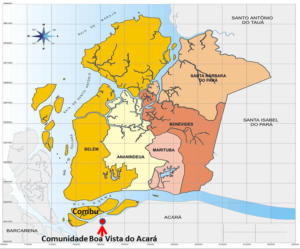
The socioeconomic dynamics of production and reproduction of the production conditions of the residents of the Boa Vista do Acará community are complex and diverse. Locally, the simple reproduction process dominates, with characteristics peculiar to the so-called Amazonian communities. These include family farming, subsistence fishing, backyard cultivation with fruit trees and the rearing of small animals, the extraction of mainly açaí and, more recently, tourism and the production of aromatic herbs sold to Natura S.A. In this context, it is important to note that the forest and traditional knowledge, passed from generation to generation, constitute the essential basis for the reproduction of the production conditions of the Boa Vista do Acará community, strongly based on the rationale of family production, contrary to the logic of capitalist companies that are ‘obliged to continuous investments and, with them, to the incorporation of scientific advances through the adoption of new techniques’ (COSTA, 1994, p. 6). In family farming of the Boa Vista do Acará community, there is a predominance of cassava flour production. The process is very simple and carried out by domestic labour. Crop cycles are usually carried out based on the traditional way of cutting and burning secondary forest, also called coivara, in which the residues of the burning are used as a natural fertilizer for the land for planting. Everything is done manually. The capoeira is opened, the cassava is planted, the tubers are removed, which are peeled, put to pubar, pressed, sieved and roasted on a copper plate under a hovel, built near the houses of the community. With Figures 1, 2, 3, 4, 5 and 6, we intend to portray a little of the ambience of the productive process peculiar to the flour roast shack. In the rustic hut, the worker with the wooden squeegee stirring the product, the oven, the furnace, the fire and the firewood, as well as some other derivatives of manioc, such as crueira and tucupi, are highlighted.
Figures 1-6: Ambience of the productive process peculiar to the flour roast shack
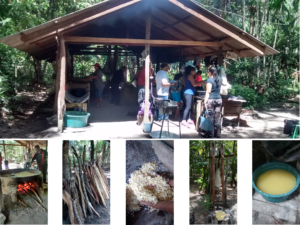 Source: Survey’s file in the discipline Qualitative Methods, 2018.
Source: Survey’s file in the discipline Qualitative Methods, 2018.
In Figures 7-9 below, some utensils necessary for the flour production chain have been specified, such as the squeegee, the iron pot used in toasting and the broom for making tapioca flour, which also serves for asepsis of the plate.
Figures 7-9: Some utensils necessary for the flour production
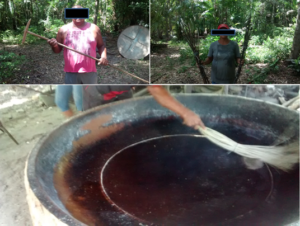 Source: Survey’s file in the discipline Qualitative Methods, 2018.
Source: Survey’s file in the discipline Qualitative Methods, 2018.
Backyards as reproduction component of material life
Riverside backyards can be characterized as part of the domestic environment, relatively limited, characterized as a low intensive management area, where the use of family labour, especially that of women, is present. In the backyards, traditional forms of cultivation of aromatic, medicinal, condiment and fruit trees are carried out, as well as the rearing of small animals, and there may even be a coexistence of plant species and wild animals. Because of this, there is a certain symbiosis between domesticated plants and animals and the reality of forests. Some authors, such as Rosa (2007), classify these yards as agroforestry. Backyards are an important component of the family reproduction process since they provide fruits, vegetables, medicinal herbs and animal protein. In general, these yards are managed without using external inputs such as agrochemicals to fight pests or weeds.
For the purpose of exposing the diversity of plants and understanding the importance of backyards in the Boa Vista do Acará community, here is a table with fruit and plant species most frequently observed locally, which are part of the diet of the riverside people and contribute greatly to their nutrient intake.
Table 1: Names of fruit and plant species in backyard agroforestry
| Popular Name | Scientific Name |
| Abacateiro | Persea Americana |
| Abacaxi | Ananas comosus |
| Açaizeiro | Euterpe oleracea |
| Acerola | Malpighia glabra |
| Alfavaca | Ocimum basilicum |
| Bananeira | Musa sp. Musaceae |
| Cacaueiro | Theobroma cacao |
| Capim-santo | Cymbopogon citratus |
| Carambola | Averrhoa carambola |
| Coqueiro | Coqueiro Cocos nucifera |
| Cupuaçuzeiro | Theobroma grandiflorium |
| Ingá cipó | cipó Ingá edulis |
| Jambeiro | Eugenia malaccensis |
| Jaqueira | Artocarpus heterophiylusl |
| Laranjeira | Citrus sp. |
| Limoeiro | Citrus sp. |
| Mamoeiro | Carica papaya |
| Mangueira | Mangifera indica |
| Murucizeiro | Byrsonima crassifolia |
| Pimenta-de-cheiro | Capsicum chinense |
| Pupunheira | Guilielma gasipaes |
| Taperebazeiro | Spondias mombim |
| Urucum | Bixa Orellana |
Source: survey’s file in the discipline Qualitative Methods, 2018.
In Figures 10-15 below, the floristic reality, as well as some small animals, which are also consumed in the community and make up the consumption of animal protein, can be seen.
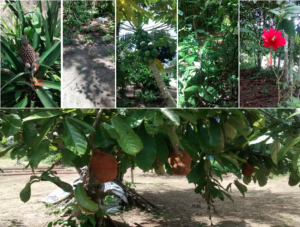 Source: survey’s file in the discipline Qualitative Methods, 2018.
Source: survey’s file in the discipline Qualitative Methods, 2018.
Tourism: Income opportunity for the community
Interacting with the diversity of flora and fauna, walking in the shade of fruit trees and productive backyards, listening to the sound of nature, experiencing the flavours of the Amazon and riverside cuisine, watching traditional practices of economic production, witnessing the collective organization of those who make their livelihood based on nature, enjoying the natural beauty and diving into crystal clear waters are privileges for anyone willing to explore the tourist potential of the Boa Vista do Acará Community. In fact, this small community welcomes those seeking such a contact with nature.
Due to its proximity to the urban centre of Belém, the area attracts tourists, especially on holidays and weekends. Despite the practice of some activities that compromise the preservation of fauna and flora, the residents still maintain a significant nature reserve, which allows long walks on trails in the shade of the trees, enjoying an ‘orchestra’ produced by the birds that make up the fauna of the locality.
At a time when there is so much talk about sustainability, ecology, preservation of the environment, etc., the residents of the Boa Vista do Acará community show in practice what this really would be. The way in which families preserve and enrich the flora and fauna near their homes, carrying out their constructions in harmony with nature, keeping animals close by, especially the countless species of birds easily seen in the small woods around the homes, shows visitors the possibility of occupying spaces without abruptly changing the dynamics of natural ecosystems.
Its diversity of fruits is remarkable, most of which are native to the region, such as açaí, bacaba, cupuaçu, bacuri, uxi, pupunha, etc. among other species cultivated by residents in their own backyards forming a kind of ‘agroforestry yard,’ for combining different species in the same space, such as pineapple, papaya, acerola. In addition to fruits, home cooking is highly appreciated. Fried fish, bean stew, white rice, farofa, fried manioc and natural juices are attracting hikers and walkers from various places contributing positively to the economy of the community’s families.
One aspect to be highlighted is the possibility of witnessing the production of manioc flour, tapioca flour, beiju (an indigenous delicacy made from manioc) and the traditional extraction of tucupi. These activities have a meaning beyond mere production; these translate the way the subjects relate and conduct the social dynamics of the community, revealing how they produce and concomitantly reproduce the conditions and material relation of their lives throughout history in the community. It should be noted that the products of cassava derivatives can also be acquired by visitors, boosting the economy and valuing the local culture. Among tourist attractions, Igarapés is one of the most sought after and visited by tourists who escape the hectic dynamics of the Pará capital. The streams cut through the geography of the community, forming several resorts that offer leisure and tranquillity to visitors. Most of these streams have icy and transparent waters which also provide local residents with a possibility of a considerable source of income. Figures 16, 17, 18 and 19 show trails, local cuisine and the pleasant igarapé bath.
Figures 16-19: A little bit of the tourist reality in the Boa Vista do Acará community
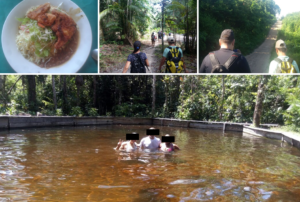 Source: Survey’s file in the discipline Qualitative Methods, 2018.
Source: Survey’s file in the discipline Qualitative Methods, 2018.
Herb production and its relationship with capital
The Boa Vista do Acará community is also known for the cultivation of herbs, sold in several places in Belém, particularly in the Ver-o-Peso market, located on the banks of Guajará Bay, a region of the historic city. Aromatic plants used in the preparation of the so-called ‘smell baths’, the final product of the process of mixing herbs that are macerated and infused in water to release their essential oils are sold here. This cultural practice is part of the popular historical knowledge, very common in the Amazon, constituting traditional knowledge transmitted from generation to generation. Among other things, it is believed that these ‘scent baths’ are used to ward off body ills, bad omen, attract good energy and even cure people who have a mild illness, such as colds, flu, headaches and others (Observation in loco, Field Note, 2018).
Among these herbs are pripriota (cyperus articulatus) and pataqueira (schizolobium parahyba), native plants that grow in areas of flooded soils in the Amazon. Understanding the market potential of aromatic herbs, the multinational cosmetics group Natura S.A, with one of its branches in the municipality of Benevides (about 30 km far from Belém), through a representative, went to the community of Boa Vista do Acará with the purpose of forming a local group of producer families and suppliers in large quantities of these herbs.
After the process of bringing Natura S.A closer to the residents of the community, technical and administrative assistance were provided for the creation and legalization of the Organic Producers Association of Boa Vista – APOBV, including the guaranteed patenting for herbs produced locally. In fact, the creation of the association was the indispensable condition to guarantee legal certainty in the company’s commercial relations with the riverside dwellers, who could produce the herbs on a large scale and supply Natura S.A almost exclusively.
In order for the cultivation of herbs and to increase the amount of traditional local production, it was necessary to promote technical training. Thus, the associated families began to promote planting using low-cost cultivation systems, with a new irrigation system, flower beds, soil management, new work equipment, and the use of rain and more pleasant temperatures in the Amazonian winter, thus, minimizing the possibility of differences in the smell and chemical composition of the herbs.
Figures: 20-23: APOBV and the cultivation of pataqueira and priprióca
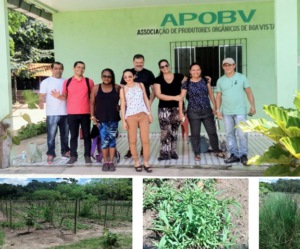 Source: Survey’s file in the discipline Qualitative Methods, 2018.
Source: Survey’s file in the discipline Qualitative Methods, 2018.
Finally, it is worth mentioning that there is a certain amount of money in the community coming from different governments at the federal, state and municipal levels, and this money greatly helps the process of maintaining and reproducing local life. Precisely, there are families that receive money from the federal government’s minimum income public policies, salaries of employees hired or tendered in connection with health and education, and income from retirement pensions for the elderly and others. All these incomes are added to the simple production and reproduction process of riverside families in the Boa Vista do Acará community, which, as noted by Silva, Santos and Souza (2016) is expressed in a symbiotic form of economy, culture, environment and religiosity (or beliefs), all intertwined in a complex relationship of dependence of these populations and their cultural, family and environmental formation, in which the elements of water and land (particularly the forest) are basic to their existences, not only material but also symbolic, particularly with regard to the sacred.
Conclusion
When discussing the existential reality of a given human collectivity, production (material and symbolic) and the reproduction of production conditions are essential to understand its functioning. There is no condition of permanence in time and space if the people who compose this collectivity are not able to reproduce, in a permanent and continuous way, their conditions of production at the same time as they produce.
In this context, it was evident that the community under analysis develops a simple production and reproduction process. By meeting the marketing needs of the company Natura S. A, the knowledge and riverside practices were transformed for the production of perfumes and cosmetics to be sold in national and international markets. In addition to these aspects, the tourist potential of the area and local cuisine were also exposed as elements that make up the process of production and reproduction of local life, since they contribute to the generation of work and income for members of local families.
Considering the points addressed in this work, it is concluded that the reality of the riverside families observed is characterized by the multiplicity of work activities in their existential productive and reproductive processes. In fact, the residents of this community have diversified forms of work and within the model of simple production and reproduction, that is, they work, produce, seal and buy goods and services with a focus on their own family consumption, not using surpluses to accumulate wealth and acquisition of more income. The local social development of families in this community comes from simple reproduction, which serves ‘[…] only as a consumption fund or is spent with the same frequency with which it is obtained’ (MARX; ENGELS, 2013, p. 782).
AUTHORS
José Bittencourt da SILVA Federal University of Pará (UFPA)
Cledinei Oliveira da SILVA State Secretariat of Education (SEDUC)
Márcio Fernando Duarte PINHEIRO Tracuateua City Hall \ PA (PMT)
Raimundo Nonato Leite de OLIVEIRA Federal University of Pará (UFPA)
Roberta da Trindade PANTOJA FUNBOSQUE (SEDUC)
REFERENCES
ALTHUSSER, Louis. Ideological state apparatus. Rio de Janeiro: Grail, 1983.
CARVALHO, André Pereira de; BARBIERI, José Carlos. Administration and Innovation Magazine, São Paulo, Vol. 10, n.1, p. 232-256, Jan./Mar. 2013. Available at: file: /// C: / Users / win7 / Downloads / document% 20 (1) .pdf. Accessed on: 06 oct. 2018.
COSTA, Francisco de Assis. Peasant rationality and sustainability. In: NAEA Papers, No. 29, p. 1-35, Nov 1994. Available at: http://webcache.googleusercontent.com/search?q=cache:4_Ax4pO4FnsJ:www.naea.ufpa.br/naea/novosite/index.php%3Faction%3DPublicacao.arquivo%26id%3D93+&cd = 1 & hl = pt-BR & ct = clnk & gl = br. Accessed on: 14 nov. 2018.
GERHARDT, Tatiana Engel; SILVEIRA, Denise Tolfo (Orgs). Research methods. Porto Alegre: UFRGS Publisher, 2009.
MARX, Karl. Contribution to the Critique of Political Economy. (Translation and introduction by Florestan Fernandes). 2nd. ed., São Paulo: Expressão Popular, 2008.
MARX, Karl; ENGELS, Friedrich. Capital: criticism of political economy. Book 1: The capital production process (translation by Rubens Enderle). São Paulo: Boitempo Editorial, 2013. Available at: https://edisciplinas.usp.br/pluginfile.php/2547757/mod_resource/content/1/MARX%2C%20Karl.%20O%20Capital.%20vol%20I.% 20Boitempo.pdf. Accessed on: 05 jun. 2018.
MEDEIROS, Jorge França da Silva. The free fairs in Belém (Pa). 2010. 118f. Dissertation (Master in Geography) – Federal University of Pará, Institute of Philosophy and Human Sciences, Graduate Program in Geography, Belém, 2010.
MORAES, Cléia dos Santos; Marcelino de Souza. Rural Tourism, income and well-being: study with family farmers in the city of Salvador do Sul, RS. In: Revista Extension Rural, DEAER / CPGExR – CCR – UFSM, Year XIV, Jan – Dec 2007. Available at: https://periodicos.ufsm.br/extensaorural/article/view/5592. Accessed on: 15 abr. 2019.
OLIVEIRA, Roberto Cardoso. Anthropologist’s work: looking, listening, writing. The work of the anthropologist. 2nd ed., Brasília: Paralelo 15; São Paulo: Unesp, 2000, p. 17-35.
ROSA, Leonilde dos Santos at al. Agroforestry yards in areas of family farmers in the municipality of Bragança-PA: floristic composition, use of species and division of family work. Brazilian Journal of Agroecology, v. 2, n. 2, p. 337- 341, 2007.
SILVA, José Bittencourt da; SANTOS, Jenijunio dos; SOUZA, Nazaré Serrat Diniz de. Basic school and riverside communities in Belém, State of Pará: Problems and Perspectives. In: KLA Working Paper, Number 18, 2016, KompetenznetzLateinamerika – Ethnicity, Citizenship, Belonging; URL: http://www.kompetenzla.uni-koeln.de/fileadmin/WP_Bittencourt.pdf.

